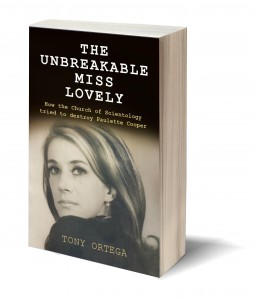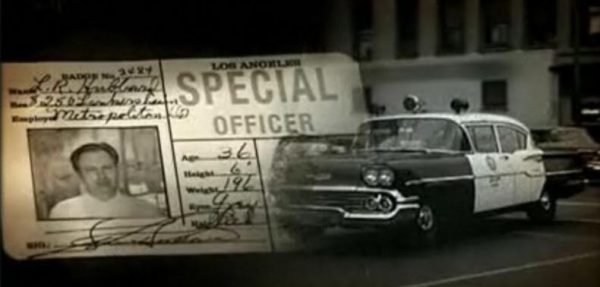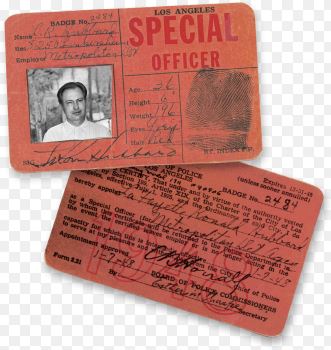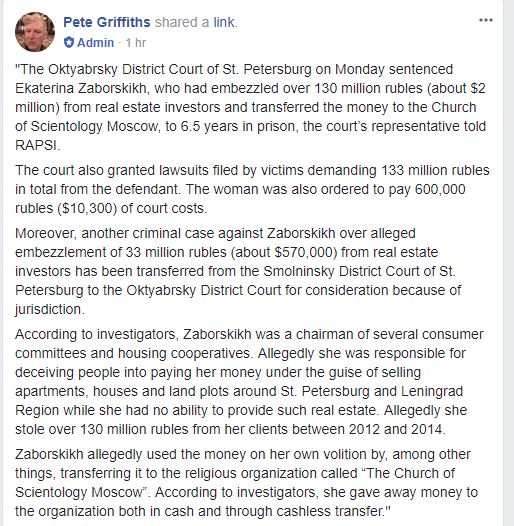We’re glad to have back Chris Owen, author of the important work Ron, The “War Hero.” Few people are as dedicated to nailing down details of L. Ron Hubbard’s history as Chris. And he has another fine addition to his work for us today.
L. Ron Hubbard (in)famously claimed to have had a distinguished wartime career as a member of the United States Navy. He also claimed distinction as a member of the National Guard and US Marine Corps, in both of which he served briefly in the 1920s and 1930s. But the US armed forces were not the only uniformed services to be graced by Hubbard’s presence.
The official Scientology version of Hubbard’s biography states that he served in the late 1940s “as a Special Officer with the Los Angeles Police Department” (LAPD). The same assertion is made on the website of Criminon, the Scientology “anti-crime” front group. In 2015, the City of Los Angeles issued a resolution recognizing Hubbard for serving “communities as a Special Officer of the LAPD where he further studied the criminal element which was the foundation for the many humanitarian and social programs which are in use throughout Los Angeles today.” The LAPD’s Operations-West Bureau also presented the Church of Scientology with a police badge mounted on a plaque dedicated to Hubbard “in appreciation for his services as a Special Officer of the City of Los Angeles.” So what is the truth behind the story of “Ron the Cop”?
Hubbard referred several times in his lectures and writings to his work as a police officer in Los Angeles. In a lecture of July 4, 1958 he told his audience: “I investigated the police one time. I became a cop.” He said on a different occasion, in a November 22, 1956 lecture, that during the development of Dianetics (in other words, before 1950) he “thought it might be an awfully good thing to become a member of a police force for a little while to find out what they were scared of. And I did – became a Special Officer in the Los Angeles Police, as I just mentioned. I wanted to find where these vicious criminals were that were making them so frightened.” His purpose in becoming “a police officer for a short time,” he wrote in Professional Auditor’s Bulletin no. 17 (1954), was “in order to observe criminality.”
In a lecture of July 18, 1961, he told Scientologists that he had “operated down in parts of Los Angeles, South Alvarado and Main and that sort of thing.” He described the area as “the seamiest, lousiest, scummiest skid row in the world” where “it’s as much as your life’s worth to go down there on a weekend. Hang around those bars and gin mills and marijuana joints. They just stack up the bodies like cord wood. It’s nothing. You pick up some guy on the corner, and he’s cut from ear to ear and bleeding gore all over the pavement. Nobody’s paying a bit of attention to him. That is too usual.”
Hubbard’s beat was “down on South Main Street … amongst the gyps, grifts, and the dopes, the hopheads, the tea eaters and the rest of them – the lowest strata of humanity that comes across from the lowest strata of Mexico to mingle with the lowest strata of Los Angeles.” He told a number of anecdotes about his experiences on the beat, which the Scientology publication Ron: The Humanitarian summarizes:
An intoxicated Native American threatens to kill the occupants of a Main Street bar for failing to serve him a drink. (The man is only mollified when LRH sits him down and convinces him a shot glass of water was the smoothest vodka in the civilized world.) Determined to resolve a quarrel with a friend, an equally intoxicated Alvarado Street resident attempts to snatch Ron’s side arm from the holster. That LRH never actually bothered to load the weapon was immaterial (“The cartridges are heavy,” he quipped). The poor wretch perceived he had been wronged and wanted revenge, and only after what amounts to a heart-to-heart talk with Special Officer Hubbard, does the offender finally conclude one did not shoot one’s friends.
“Special Officer Hubbard” claimed he had been so successful in keeping the peace in the area that people “kept trying to hire me, by the way, because it was bad for business to have these brawls, and so forth, occur. And I’ve been offered some very fancy sums to keep on with this job.” He found this hugely amusing and entertaining, as he kept being mistaken for “the real McCoy” – a real police officer. In a moment of perhaps unintentional honesty he admitted, “boy, that’s the biggest fraudulence I ever pulled in my life.”
The truth behind these claims is, as usual with Hubbard, considerably less remarkable than suggested by his anecdotes. Scientology archivists discovered among Hubbard’s personal effects a metal badge, numbered 2484, and an identification card connected with his service as a Special Officer. Dated January 7, 1948, the card shows Hubbard’s photograph and biometric details (age 36, height 6 feet, weight 196 lb) and his right index fingerprint.
This last detail caused the card to be brought to public attention, apparently for the first time, in May 1983. After Hubbard disappeared from public view at the start of the 1980s, his estranged son L. Ron Hubbard Jr. (by then known as Ron DeWolf) sued over the disposition of his estate following reports that Hubbard had died or was incompetent and this was being covered up by the Church of Scientology. Hubbard’s lawyers disproved this by having Hubbard write a letter which he vouchsafed with his fingerprints. An LAPD fingerprint expert used the 1948 ID card and other documentation to confirm that the fingerprints on the letter were in fact Hubbard’s. The fingerprint on the card likely comes from a full set of fingerprints taken by the LAPD on December 31, 1947, presumably in connection with Hubbard’s application for a Special Officer permit.
The card, which is signed by the Chief of the LAPD, Clarence B. Horrall, does not identify Hubbard as an LAPD officer. He is described instead as a “Los Angeles Special Officer.” His employer is listed on the reverse as the Metropolitan Detective Agency. City ordinances required him to have a licence from the Los Angeles Police Commissioners to operate as a Special Officer, but he did not work for the LAPD. The Church of Scientology’s frequent claims that he was a “Special Officer of the LAPD” are therefore simply false.
The Metropolitan Detective Agency was founded in Monterey, California in 1936 and still operates today. Like a number of other private security companies, it provided patrol and guard services to the City of Los Angeles and business associations in particular districts. The LAPD has long had one of the lowest ratios of police personnel to population served of any American city, despite being one of the largest police departments in the country. Special Officers are still used to supplement law enforcement personnel in the city. They wear caps, badges and uniforms (in gray rather than police blue) and can carry firearms. According to the City of Los Angeles…
A Special Officer is a sworn peace officer, authorized to carry a firearm who enforces federal and state regulations, City of Los Angeles ordinances, and security, traffic, and safety rules and regulations; engages in law enforcement activities, including uniformed foot, vehicle, bicycle patrol and plainclothes assignments, arrest, and report writing at the Department of General Services; provides information to the public regarding locations and operations of the Department; engages in hazardous materials enforcement; and does related work.
What did Hubbard’s work for the Metropolitan Detective Agency entail? According to Scientology’s account, “In all LRH conducted forty-five patrols in the Central Division notoriously known as the dark heart of the city which covered seventeen square miles beyond First and Main Streets. Primary duties included guarding properties such as banks and warehouses, and the patrolling of the general neighborhood on behalf of local merchants.” In other words, he was a security guard.
Hubbard’s self-serving explanation that he was conducting research on criminality is not supported by any contemporary evidence. The date and address given on his ID card provide some clues as to why he chose to take the job. Issued on January 7, 1948, it records that he was living at 8250 Lankersheim Boulevard in North Hollywood. At the time, this was the Valley Trailer Park, located in a decidedly seedy area of the city. Hubbard had moved there with his wife Sara in July 1947. He was trying to relaunch his pre-war career as a writer of pulp science fiction stories but struggled to sell stories and was not making nearly enough money from writing to support himself or his dependents.
Hubbard’s letters from this time record his financial difficulties. In October 1947 he enrolled at the Geller Theater Workshop on the corner of Fairfax and Wilshire to gain an extra $90 a month subsistence from the Veterans Administration, though he gave up on the workshop after only six weeks. He detailed his financial plight in a letter to the VA dated January 27, 1948 – less than three weeks after he obtained his Special Officer licence – in which he wrote:
“I am nearly penniless and have but $28.50 to last me for nearly a month to come. Since leaving school [i.e. the Geller Theater Workshop] in mid-November I have made $115 from various sources – about $40 from the sale of two bits to magazines in late November and the repayment of a bad debt for $75. These comprise my income to date except for the sale of a typewriter tonight for the above $28.50. My expenditures consist of $27 a month trailer rent and $80 a month food for my wife and self, which includes gas, cigarettes and all incidentals.”
He did not mention whatever he might have been earning from the Metropolitan Detective Agency. It is not clear whether this was a deliberate omission to make his financial problems seem worse than they really were, or whether he had not yet received his first wages from the company. It probably would not have been a substantial salary, but given his shortage of money any extra income would have been very desirable.
By Hubbard’s own account, his service as a Special Officer was “short.” He did not say why, but it may have had something to do with his arrest and conviction for petty theft in the summer of 1948. On August 5, 1948, he was charged with the offense by a John Baldwin of 3429 East Colorado Boulevard in East Pasadena. By that point Hubbard was living at 1644 North Hill Street in Los Angeles. An arrest warrant was issued and was carried out on August 17 by the local police in San Luis Obispo, 200 miles northwest of the city. They took an impression of his fingerprints which was later passed to Interpol. After being released on $500 bail he was arraigned in San Gabriel in Los Angeles County.
Hubbard initially pleaded not guilty but changed his plea on August 31 to guilty and was fined $25. The details of the offense are not known, as the file was destroyed in 1955, but according to FBI records it related to checks. It was therefore probably some kind of check fraud, most likely involving paying with a check that did not clear.
At the time 3429 East Colorado Boulevard appears to have been occupied by a trailer sales center called Pacific Trailer Sales. Hubbard was probably still chronically short of funds and may have resorted to using a check to pay for a trailer-related item, perhaps a spare part, without having sufficient funds in his bank account to clear the check. He had a repeated history of failing to pay creditors, from Puerto Rican hoteliers in the 1930s to Alaskan banks and Australian tailors in the 1940s (and in the 1950s left a trail of debts behind him from his Dianetics Foundations).
A conviction would have made it impossible for him to continue working as a Special Officer, as holding the licence depended on having a clean record. Soon afterwards, Hubbard and his wife moved to Savannah, Georgia. His subsequent experience with law enforcement was limited to writing letters to the FBI denouncing his associates, including his wife, and evading scrutiny from law enforcement agencies around the world.
Hubbard never mentioned his conviction for petty theft to his followers and wrote in 1954, with no apparent realization of any irony or hypocrisy:
“It is my close observation that anyone subject to criminal tendencies is, in a much broader sense, insane, and that his insanity reaches much wider than the field of crime, but invades persecution and mental disabilities which are in themselves symptoms of insanity.”
— Chris Owen
——————–
Russia’s Reed Slatkin sentenced to prison
Pete Griffiths with an update from Russia in a scammer sentenced to prison there who was ripping people off in real estate deals and then feeding the money to Scientology…
——————–
Bernie Headley has not seen his daughter Stephanie in 4,918 days.
Brian Sheen has not seen his grandson Leo in 64 days.
Clarissa Adams has not seen her parents Walter and Irmin Huber in 1,127 days.
Carol Nyburg has not seen her daughter Nancy in 1,901 days.
Jamie Sorrentini Lugli has not seen her father Irving in 2,675 days.
Quailynn McDaniel has not seen her brother Sean in 2,021 days.
Claudio and Renata Lugli have not seen their son Flavio in 2,515 days.
Sara Goldberg has not seen her daughter Ashley in 1,555 days.
Lori Hodgson has not seen her son Jeremy and daughter Jessica in 1,267 days.
Marie Bilheimer has not seen her mother June in 793 days.
Joe Reaiche has not seen his daughter Alanna Masterson in 4,882 days
Derek Bloch has not seen his father Darren in 2,022 days.
Cindy Plahuta has not seen her daughter Kara in 2,342 days.
Claire Headley has not seen her mother Gen in 2,317 days.
Ramana Dienes-Browning has not seen her mother Jancis in 673 days.
Mike Rinder has not seen his son Benjamin and daughter Taryn in 4,975 days.
Brian Sheen has not seen his daughter Spring in 1,081 days.
Skip Young has not seen his daughters Megan and Alexis for 1,484 days.
Mary Kahn has not seen her son Sammy in 1,357 days.
Lois Reisdorf has not seen her son Craig in 938 days.
Phil and Willie Jones have not seen their son Mike and daughter Emily in 1,443 days.
Mary Jane Sterne has not seen her daughter Samantha in 1,687 days.
Kate Bornstein has not seen her daughter Jessica in 12,796 days.
——————–
 Posted by Tony Ortega on October 30, 2017 at 07:00
Posted by Tony Ortega on October 30, 2017 at 07:00
E-mail tips and story ideas to tonyo94 AT gmail DOT com or follow us on Twitter. We post behind-the-scenes updates at our Facebook author page. After every new story we send out an alert to our e-mail list and our FB page.
Our book, The Unbreakable Miss Lovely: How the Church of Scientology tried to destroy Paulette Cooper, is on sale at Amazon in paperback, Kindle, and audiobook versions. We’ve posted photographs of Paulette and scenes from her life at a separate location. Reader Sookie put together a complete index. More information can also be found at the book’s dedicated page.
The Best of the Underground Bunker, 1995-2016 Just starting out here? We’ve picked out the most important stories we’ve covered here at the Undergound Bunker (2012-2016), The Village Voice (2008-2012), New Times Los Angeles (1999-2002) and the Phoenix New Times (1995-1999)
Learn about Scientology with our numerous series with experts…
BLOGGING DIANETICS: We read Scientology’s founding text cover to cover with the help of L.A. attorney and former church member Vance Woodward
UP THE BRIDGE: Claire Headley and Bruce Hines train us as Scientologists
GETTING OUR ETHICS IN: Jefferson Hawkins explains Scientology’s system of justice
SCIENTOLOGY MYTHBUSTING: Historian Jon Atack discusses key Scientology concepts
Other links: Shelly Miscavige, ten years gone | The Lisa McPherson story told in real time | The Cathriona White stories | The Leah Remini ‘Knowledge Reports’ | Hear audio of a Scientology excommunication | Scientology’s little day care of horrors | Whatever happened to Steve Fishman? | Felony charges for Scientology’s drug rehab scam | Why Scientology digs bomb-proof vaults in the desert | PZ Myers reads L. Ron Hubbard’s “A History of Man” | Scientology’s Master Spies | Scientology’s Private Dancer | The mystery of the richest Scientologist and his wayward sons | Scientology’s shocking mistreatment of the mentally ill | Scientology boasts about assistance from Google | The Underground Bunker’s Official Theme Song | The Underground Bunker FAQ
Our Guide to Alex Gibney’s film ‘Going Clear,’ and our pages about its principal figures…
Jason Beghe | Tom DeVocht | Sara Goldberg | Paul Haggis | Mark “Marty” Rathbun | Mike Rinder | Spanky Taylor | Hana Whitfield









